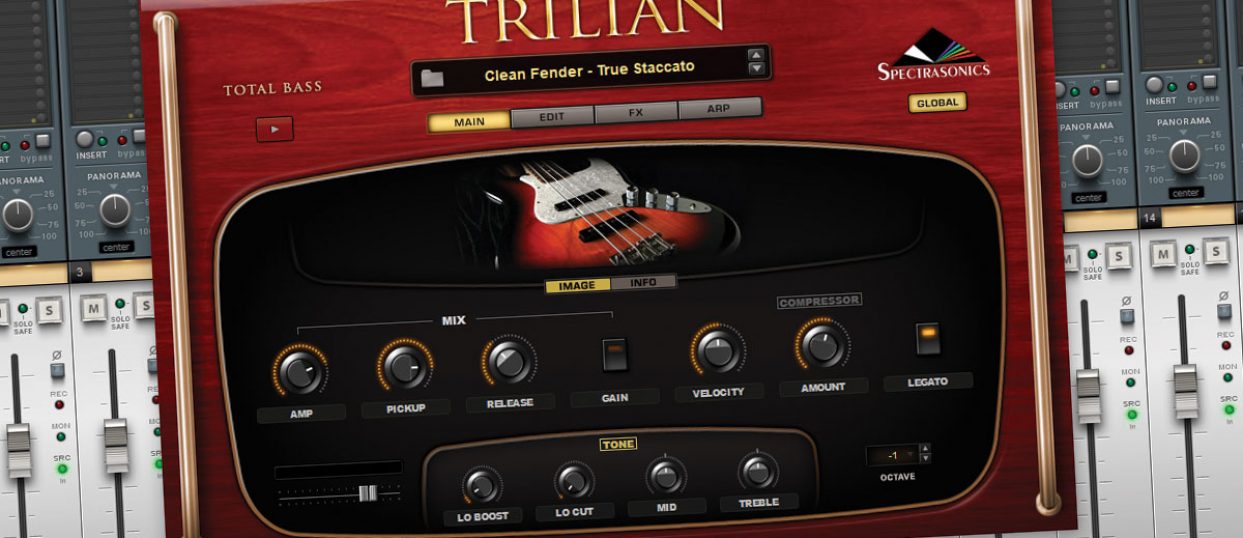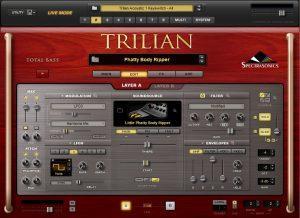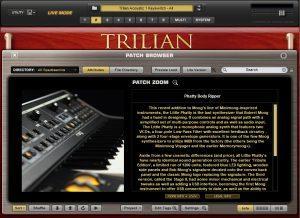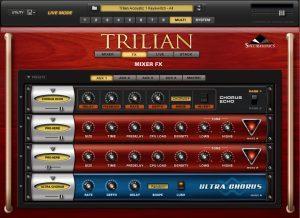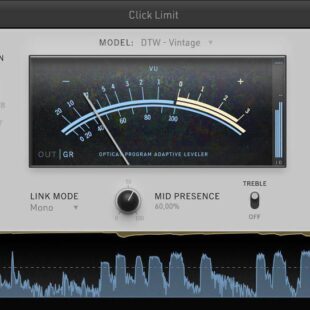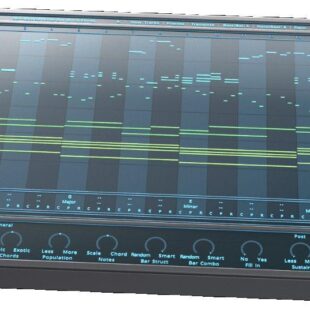Spectrasonics Trilian – Low so good!
Somewhat of an updated version of Spectrasonics Trilogy synth, the new Trilian platform is kin to Spectrasonic’s Omnisphere and shares much of its workflow. The library comes on 4 DVDs and is around 34GB in size once fully installed, so it’s a monster.
Using the new ‘Steam Engine’, Trilian offers a massive collection of synth and analogue bass patches that run with full synthesis and FX layers. In addition, you get plenty of performance mods like dynamic round robins, automatic legato and an intuitive ‘live mode’ for applying your own custom articulations.
A large chunk of the massive install is dedicated to the excellent acoustic double bass, plus a smattering of classic electric basses – Fender Precision, Jazz, a Music Man 5 string and the interesting Chapman Stick. There are a bunch of very well-sampled bass-focused synths like the ARP 2600, Moog Taurus pedal bass, Yamaha CS-80 and Dave Smith’s Tetra. On top of all of this you get all of the original but remastered Trilogy samples – totalling around 350 basses.
Though the synth engine isn’t as featured as its Omnishpere brother (sister?), you do get advanced control with 19 twin filters per instrument, 6 LFOs, FM and Harmonia effects. The modulation section features 26 sources to 47 targets, with a full mod matrix interface – all of this twice for layers A and B for each bank, it’s a fairly serious synth.
Road Test
The big show pony is the new acoustic double bass, and yes it sounds pretty convincing. In full range mode, you get 12 (!!) velocity layers with 16 round-robin chances per note. It’s not as demanding on the CPU as you might expect either, we found performing with everything enabled was seamless and very expressive. Out of the box, the bass is very aggressive and throaty, so some fiddling with the pickup controls is required to pull it back a little.
Speaking of controls, each bass patch has its own preset macro interface, usually consisting of a mic mix, compressor and EQ options. The acoustic bass features U-147 Mic, pickup and noises mix, legato, velocity intensity, compressor, humanize and 4-band EQ. So plenty of customisation before you even get into the synthesis section.
Playing the bass is a breeze on the keyboard, and features nicely implemented slides, glissando, staccato and ghost note articulations. The velocity out of the box is pretty much perfect for most jazz numbers, but you’ll need to kick it up a little for more slappy rockabilly-style stuff.
Overall though, very impressive instrument and so far better than anything we’ve seen so far out there. Somewhat backline to the acoustic bass is the electric selections, all of which sound great, though don’t offer the same detailed playability of the acoustic. Though, unlike any other bass library we’ve tried, this is the only one that features natural legato on held notes – so playing straight 8th note rock bass sounds fantastic by simply holding down the sustain pedal and playing.
Working with the synth basses is mostly easy, as the browser is divided smarty by basic categories (ARPs, stereo and mono), types (aggressive, drones, retro etc), genre and model – which is perfect for my monkey brain, as all I wanna know right off the cuff is ‘where da Moogs at?!’
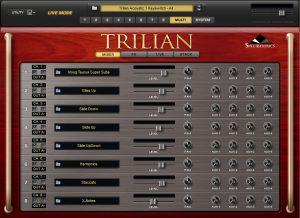
Each of the patches includes an interesting background on the synth and of course, its own custom GUI macro controls as mentioned before. Bar pretty much none, all of the synth patches we listened to sound insane. For a start, everything is very well sampled and balanced, you can pretty much drop these right into your mix project and bounce for mastering they’re that good. Of the hardware synths we have here in the Music Nation studio – the Juno 106, Obi Matrix 1000 and Jupiter80, everything we found that matched the real-life counterpart was spot on the money. Though I’m a big fan of tactile hardware synths, there’s not much need to go crazy now hunting down the rare boards – everything you need is right here.
Trilian gets a little CPU hungry quickly, so be prepared to start freezing tracks down or rendering larger presets. We also noticed a MIDI issue in Reaper and Cubase when bouncing down MIDI tracks that have glissando and slides not transferring to the audio bounce. Not sure if this is Trilian or a DAW issue, but hopefully something covered in future patches of either.
Conclusion
So in finishing, this has been a very enjoyable trip into bass heaven. Trilian is rather heavily focused on the acoustic double and synth basses, the electric slightly takes a backline role, which is a shame there are not a few more variants – even a Steinberger would be nice.
Unless you’re running a fairly cutting-edge machine, you might experience some DSP issues, especially if you’re running other real-time instruments – now might be a great time for a PC birthday overhaul while you’re out spending money on VSTIs. At $500 USD, Trilian is a bit eye-watering and pricey, but just grin and think of England – the value for money when you strip it down is amazing. I do admit, though, if you’re planning on, or have brought, Omnisphere and Stylus RMX, this is going to push even the most wife-friendly credit card budget. Unfortunately, at this time of writing, Spectrasonics have no bundle or package deal for all three.
So this is it – the best bass-focused instrument on the market, yes – easily. There is a metric tonne of amazing historic and accurately sampled synths to keep any producer sorted for low-end inspiration for a long time to come. Of course, the orchestral and jazz guys will be delighted with the traditional section of Trilian, most likely leaving all the synthesis stuff to gather dust.
Amazing collection and a required purchase for every producer.
Full details and purchasing options from the Spectrasonics website www.spectrasonics.net

